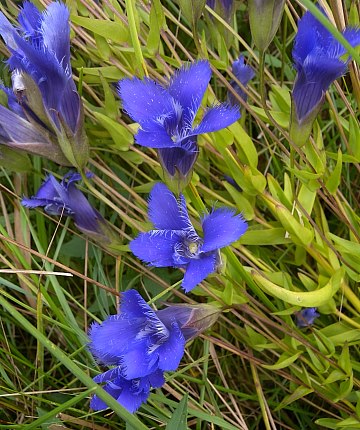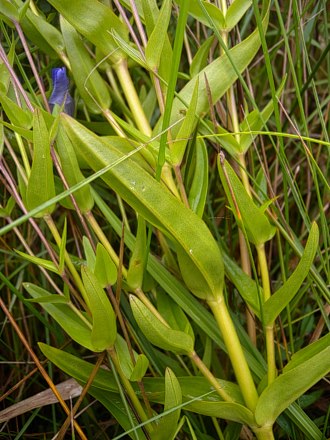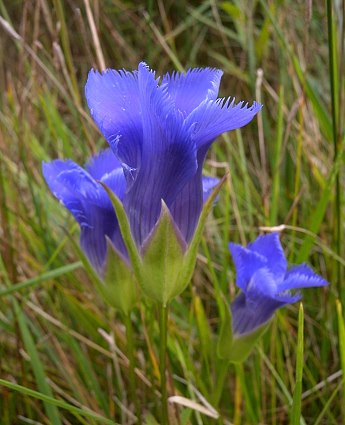
Upper stems terminate with individual flowers on long peduncles (up to 8" in length). Each flower is 1½-2½" long, consisting of a broad tubular corolla with spreading 4 lobes that are rounded and fringed, 4 lanceolate to ovate sepals that are about one-half the length of the corolla, 4 inserted stamens, and a pistil with a short style. The corolla varies in color from medium blue to deep dark blue. The sepals are light green to reddish green, glabrous, and keeled; 2 sepals are shorter than the other 2 sepals. The shorter sepals have membranous margins. The upright peduncles are light green to reddish green and glabrous; they are terete and sometimes slightly ribbed (striated). The blooming period occurs from early to mid-fall and lasts about 1½-2 months. The flowers are diurnal, opening up on sunny days, while remaining closed on cloudy days and during the night. There is no noticeable floral scent. The flowers
 are replaced by elongated
seed
capsules. Individual capsules divide into 2 parts to release the
numerous tiny seeds within. To some
extent, they are distributed by
wind and water. The seed surface is minutely bumpy. The root system
consists of a shallow branching taproot. This wildflower reproduces by
reseeding itself.
are replaced by elongated
seed
capsules. Individual capsules divide into 2 parts to release the
numerous tiny seeds within. To some
extent, they are distributed by
wind and water. The seed surface is minutely bumpy. The root system
consists of a shallow branching taproot. This wildflower reproduces by
reseeding itself.Cultivation: The preference is full or partial sun, somewhat wet to moist conditions, and calcareous sandy soil with a neutral pH. Insect pests and disease organisms rarely bother this wildflower. Robust plants can sprawl if they are not supported by adjacent vegetation.
Range & Habitat: Fringed Gentian is a rare native wildflower that is found in NE Illinois, while in the rest of the state it is absent (see Distribution Map). While populations have declined from habitat destruction, Fringed Gentian is not yet listed as 'endangered' or 'threatened' within the state. Habitats include wet to moist sand prairies, sandy pannes near Lake Michigan, edges of sandy sloughs and sandy swales, fens, open wooded swamps, wooded ravines, roadside ditches, and open damp areas along sandy trails. Fringed Gentian is usually associated with high quality wetlands where the original flora is still intact, although it has a tendency to colonize open disturbed areas both in and around these habitats.
Faunal Associations: Information about floral-faunal relationships for this wildflower is scant. The nectar and pollen of the flowers attract primarily bumblebees. Costelloe (1988) observed the following bumblebees visiting the flowers of Fringed Gentian in Ohio: Bombus fervidus, Bombus impatiens, Bombus perplexus, and Bombus vagans. Apparently, the bitter foliage is rarely bothered by insects and mammalian herbivores.
Photographic Location: Edge of a wet sandy meadow along a trail at the Indiana Dunes National Lakeshore in NW Indiana.

Comments: The flowers have an unearthly beauty that is positively stunning; Fringed Gentian ranks among the most attractive of all wildflowers within Illinois. Another similar species in this genus is Gentianopsis procera (Lesser Fringed Gentian). This latter species is a petite version of Fringed Gentian: it is usually shorter with smaller flowers and leaves. The flowers of Lesser Fringed Gentian have corolla lobes that are less deeply fringed, and its leaves are more narrow (becoming linear-lanceolate to nearly linear underneath the flowers). Lesser Fringed Gentian is even less common than Fringed Gentian, preferring similar to slightly wetter habitats. Another common name of Gentianopsis crinita is Greater Fringed Gentian; a scientific synonym of this species is Gentiana crinita.